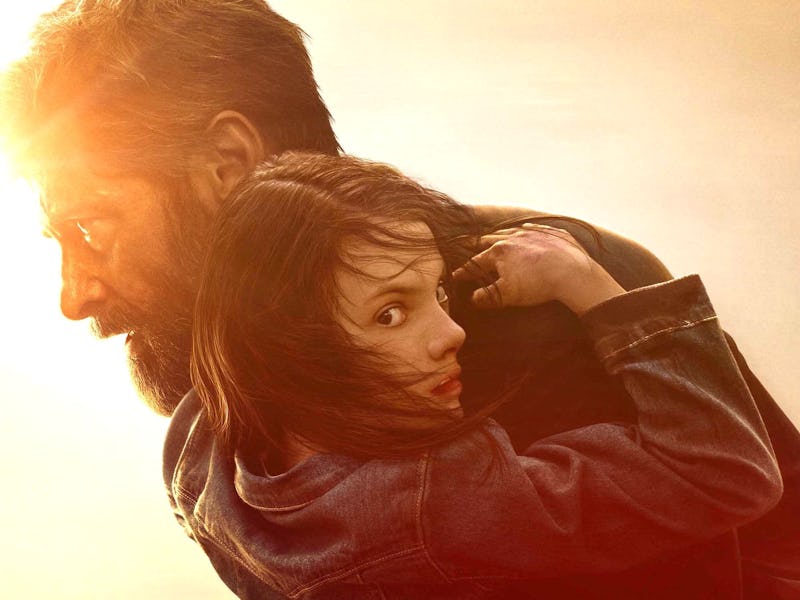'Logan' Is Great Because It Has an Ending
Proof superhero movies can feel like regular movies, too.

Roughly 17 years after the first X-Men movie, the endless torrent of super-sequels have delighted fans but led to a weakness: Even the best of these films lacks real tension because audiences know the movies aren’t really going to end. Mercifully, Logan bucks this trend and becomes a different cinematic beast. It’s a superhero movie that dares to have a beginning, middle and — radically — an ending, too.
Spoilers for Logan ahead.
It shouldn’t be revolutionary that there’s no post-credits sequence in Logan, but these days, it counts as a major piece of news. As the film’s director James Mangold said recently, “If there’s normally a cameo or an end-credit scene, we’re not doing that.” The film doesn’t rely on the tension of a vague future installment to make audiences care. Instead, the internal conflicts of Logan are all set up early in the film and resolve themselves by the end. In a way, you could even read Logan as a true standalone film. Sure, it’s helpful if you knew who Wolverine and Professor X were prior to seeing it, but there’s enough information in the movie as it is to make everything work. Plus, Hugh Jackman and Patrick Stewart are making these characters work with real human moments, not by participating in a crazy story.
With its road trip-style plot, Logan is the opposite of the storylines of actual comic books, a medium which Logan openly mocks in the film. He tells Laura that the fake stories of the X-Men exist in comic books, meaning what we’re watching in Logan is the real thing.
Plots in most non-superhero movies aren’t like the plots of comic books. Transporting superhero stories from the medium of comics to the medium of films has always been painful, mostly because comics are intentionally written to be incomplete stories. But cliffhangers and post-credits teases in various superhero films have become tedious. Like puzzles, comic book plots only make sense when many pieces are put together, and even then, clarity is questionable. Tellingly, the ersatz X-Men comic books that Logan’s daughter, Laura, has in this film were bespoke for the film itself. In February Mangold revealed to Slashfilm that the comics aren’t based on “real” vintage comics, nor were they complete mock ups. “They’re not complete,” he said, “Just the pages we needed.”
This attitude pervades the entirety of Logan, which is why the film is so satisfying. It’s nice if you catch the reference Logan and Xavier make to the Mutant academy, or to the Statue of Liberty from the first X-Men movie, but the audience also isn’t required to take these brief references seriously, or literally. Plus, because Xavier is suffering from some sort of dementia, a hazy memory of previous X-Men adventures works internally for this movie. Do we need to know where this film works in the timeline? No. Its own internal continuity establishes that everything you’ve heard about the X-Men prior to this is questionable. Logan subsumes the other X-Men movies casually, mostly by not really caring about them from a granular canon perspective. Everything in this movie serves to move its own story forward.
Take this in contrast with the bizarre Jean Grey flashbacks in 2013’s supposed standalone movie The Wolverine. In theory, these Jean Grey flashbacks require the audience to have seen X-Men: The Last Stand, seven years prior. There’s none of that in Logan. There are no dream sequences, flashbacks, or clunky voiceovers explaining events. It’s a mature storytelling approach that respects its audience, a strategy a lot of other movies employ, just not usually movies with superheroes.
In conventional cinema, endings are necessary to provide some kind of meaning to the narrative. But most comic books avoid definitive endings. Heroes can be reborn in the science fiction of comic books but not this time. This time, the Wolverine is really dead, or at least this version of him. As Logan says in the movie, “This isn’t like a comic book where someone is resurrected with a cool new costume.”
Even so, as his daughter Laura and the other children bury Logan, he might symbolically revert to the costumed hero they love: the immortal Wolverine whose adventures maybe never even happened. At Logan’s small burial, one child even clutches a toy version of the character, clad in the yellow spandex of old. In providing an ending for the adult fans of the X-Men, Logan tastefully handed the stories back to the children in the end. James Mangold knows other X-Men films will be made. Other comic book movies, despite how gritty they get are still for children or adult fans craving stories without true consequences. The comic book adventures aren’t real, but as Xavier reminds Logan, that’s not true for the children. “They’re real for Laura,” he says.
By giving audiences a thrilling ride with an ending completely earned, this comic book story wasn’t for Logan’s daughter or her friends. Instead, it was for the adults in the audience who maybe once saw themselves as cranky old man with claws coming out of his hands. If you loved the movie, you probably left the theater as the credits were still rolling. You knew there wasn’t a post-credits sequence because this was a real ending.